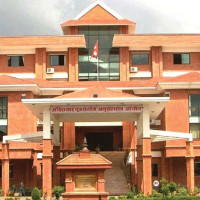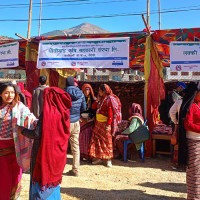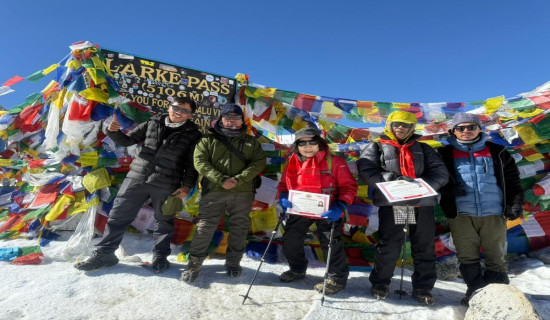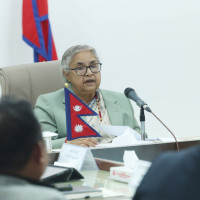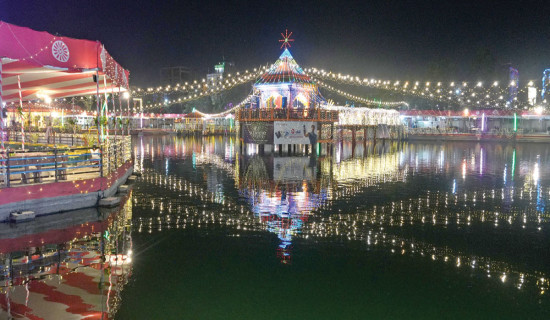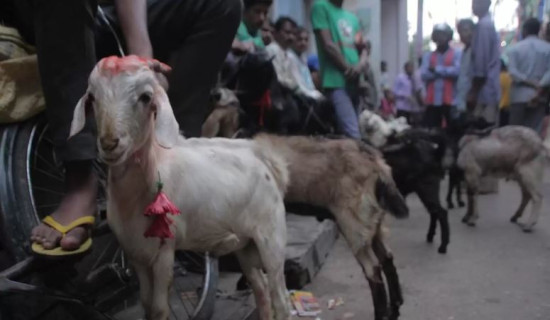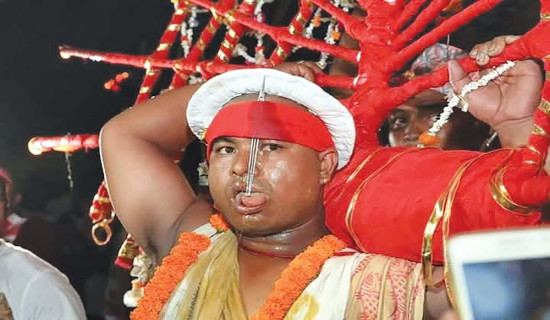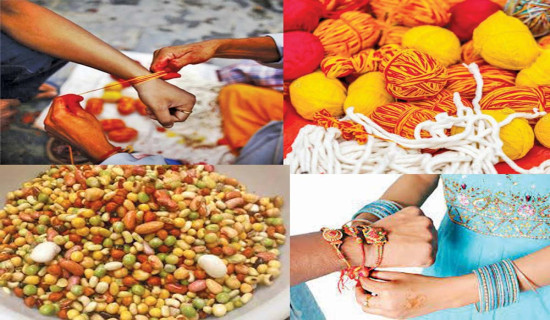- Monday, 15 December 2025
Eight-month long ritual dance series concludes
Kathmandu, June 23: Last Wednesday, after eight months of performing ritual dances across various parts of the Kathmandu Valley—including areas beyond Ring Road—and blessing viewers and devotees, the Navadurga dance troupe concluded its season with a final performance at the Navadurga Temple, near Dyah Chen courtyard in Gachen, Bhaktapur.
The day, known as Bhalbhala Ashtami, marked the end of the eight-month-long series of street dances related to Navadurga. It concluded with a symbolic fall to the ground, representing the death of the Navadurga devgans (deity performers). As part of the final rites, the masks worn by the 13 Navadurga devgan were immersed in the Brahmayani River and then burned—signifying the cremation of the deities.
On this day, all 13 devgans of Navadurga emerge from the ‘Dev Ghar’ (god house) in the Dyah Chen courtyard and perform a lamentation dance at the Navadurga Temple in Ward No. 9, a 10-minute walk from the Dev Ghar, said Narayan Man Banmala, the founder President of the Banmala Society, which was established in 1993 (2050 BS).
Every year on Bhalbhala Ashtami, the devgans symbolically present the death cycle, artistically reflecting the pain experienced in the final moments before death. It is believed that the Navadurga deities who "die" on this day will be reborn during the Dashain festival. “This symbolises the cycle of death and rebirth in human society,” he said.
On Ghantakarna Chaturdashi (also known as Gathe Muga day), the newly created masks of the Navadurga deities are formally assigned thier names, according to the Banmala Society president. From this day onward, no other festivals are observed until Gathe Muga or Ghantakarna. When the monsoon rains begin to recede, the festival cycle resumes.
Sharing his own painful experience of being forcibly deprived of education due to the traditional obligation to become a devgan in the Navadurga dance group, he explained that among the many age-old traditional dances performed annually in various localities, the Navadurga dance (Dance of Navadurga) stands out. It is performed in numerous areas over an eight-month period.
Most Banmala people, a traditional dance group of the Newar community, are not well educated, largely because they are engaged year-round in ritual dance activities. Many are compelled to participate from a young age, leading them to abandon their studies. The dance tradition, which originates primarily from Gachen, Bhaktapur, is performed to preserve culture and continue ancestral professions.
However, their economic and educational conditions remain poor, he said.
For about eight months each year, the Banmalas perform the culturally significant Navadurga dance at 21 locations across the ancient town of Bhaktapur, as well as in Changunarayan, Sanga, Banepa, Dhulikhel, Panauti, Tokha, and Sankhu.
The rest of their time is spent preparing for dances and performing related rituals. This leaves little opportunity for personal chores, family responsibilities, or education.
“I could not pass school-level education because I had to dedicate so much time and energy to rehearsing, performing, and following daily ritual practices,” said Narayan Man.
As holy dancers, this group within the Newar ethnicity must follow strict rules and abstentions during the dance season to embody deities such as Bhairav, Mahakali, Barahi, Brahmayani, Maheshwari, Kumari, Vaishnavi, Indrayani, Ganesh, Mahadev, Seto Bhairav, and two lion figures (Nandi and Bhringi). Some of the performers are as young as eight years old and are kept out of school. Besides hindering education, the physically demanding dances also lead to health issues.
The devgans often perform barefoot from morning to evening while wearing masks that can weigh up to 13 kilograms. “It’s very demanding on the body,” said Banmala. “We suffer from chest pains and stomach aches.”
"Unfortunately, the community that has devoted their lives to preserving and continuing the ancestral traditional street dance still struggles with low living standards and poor educational status. Yet, the government remains inactive. That is why the government should take the initiative to preserve this national cultural heritage," said Purusotam Lochan Shrestha, a cultural expert.
"They earn only a small amount from these performances, which they rely on for their livelihood, leaving them with little time or resources to pursue education," he added, emphasizing the urgent need for government support to sustain this valuable tradition.
Despite these hardships, the Banmala community of Bhaktapur continues to uphold this Malla-era dance tradition, which was started by King Bhuwan Malla in the 16th century. It is believed that the king initiated the Navadurga dance to protect the nation from calamities such as drought, disease, and famine.




